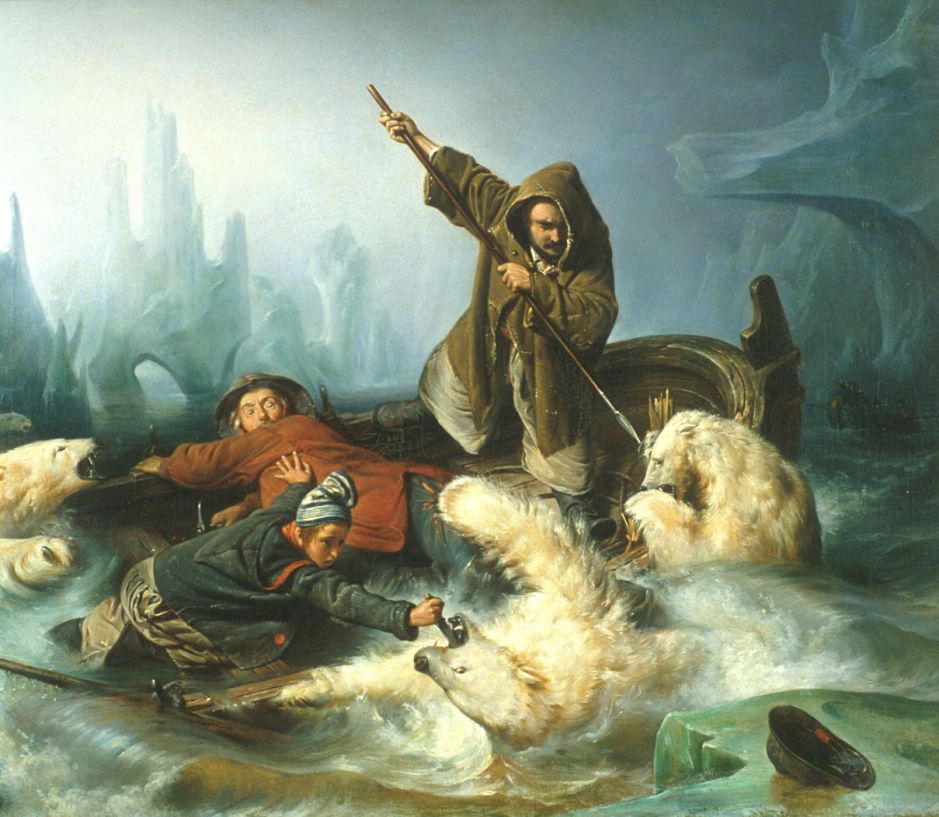The coming week’s play by Shakespeare will be The Tempest, which opens with a ship being wrecked on a remote island, so this weekend I look at a selection of paintings showing shipwrecks.
Until the popularisation of air travel in the late twentieth century, there were only two options for many longer journeys: slowly and painfully overland, with its attendant risk of murder by brigands, or by sea, with its hazards of pirates and shipwreck. The remains of countless ships are now littered around the coasts of Europe, grim evidence of just how many voyages never reached their destination.

Tintoretto’s St Mark Rescues a Saracen is a stormy nocturne showing a story from the Golden Legend in which Saint Mark is claimed to have saved a ‘Saracen’ (an Arab) from drowning in a shipwreck, as he had made a vow that if so rescued, he would be baptised as a Christian. After his rescue, the Saracen failed to meet his promise, so Saint Mark appeared and reminded him of his vow, and the Saracen went to Venice and was baptised in the saint’s name.

By the early eighteenth century, landscape artists were starting to paint views of the coast during storms, such as Alessandro Magnasco’s Landscape with Stormy Sea, from between 1718-25. Born and resident in Genoa, he would have been only too familiar with the storms of the Mediterranean and their short, steep seas, just as shown here.

Claude Vernet’s A Storm on a Mediterranean Coast (1767) combines a wrecking with keenly-observed signs of the weather, including the coincidence of reflected and oncoming waves just off its small beach, and the trees at the upper left. Although this was painted in the studio, Vernet probably worked from sketches he had made during storms.

Although it has been suggested that Goya’s Shipwreck (1793-94) might show the Biblical flood, the breaking waves and rocky coastline make it most likely to show survivors coming ashore from a stricken vessel, and this is confirmed by a couple of barrels as flotsam to the left. Although Goya spent much of his life inland, he had also travelled by sea, and must have been familiar with many stories of shipwreck.
Géricault’s monumental painting of The Raft of the Medusa (1818-19) shows the distressed survivors of an infamous shipwreck.

The end result of over a year’s painstaking research and studies by the artist is a vast canvas, its figures life-sized, which has had huge impact on everyone who has seen it since 1819. Its relatively traditional approach and attention to detail give it the air of complete authenticity, although Géricault carefully manipulated its composition in several ways to make his point. For example, he shows the few survivors crowded together on a small part of the raft, and crops the image tightly to give the impression that the raft was overcrowded, which it wasn’t.

Late in his career, JMW Turner painted several radical views of storms at sea. His Wreckers – Coast of Northumberland, with a Steam-Boat Assisting a Ship off Shore from 1833-34 shows a sailing ship in distress near Dunstanburgh Castle in a storm. The implication in the title is that the people in the foreground are salvaging cargo from the beach; whether they played a role in luring the vessel onto the rocks isn’t clear.

Eugène Lepoittevin’s Shipwrecked from 1839 shows the surviving crew of the wrecked ship in the background, which has struck an iceberg in the Arctic. The sailor standing, wearing a red jacket, is fending off a polar bear, one of four in the water to the right. Below is François-Auguste Biard’s painting of Fight with Polar Bears, a more thrilling treatment of the same theme, and painted in the same year.

Biard completed this just prior to his departure on an Arctic expedition, and exhibited it at the Salon that year. It’s sometimes assumed that this shows a real or dramatised episode from the expedition, but it was painted before he had even left France. Two men and a boy are in a small boat, which is being attacked by three adult polar bears. They’re trying to repel them using a spear-like harpoon, a hand knife, and an axe, as the bears are threatening to overwhelm their small boat and wound them.

